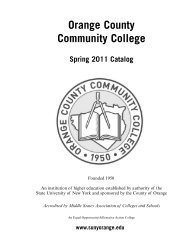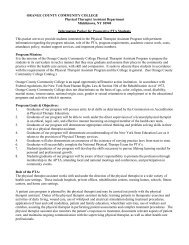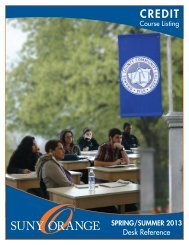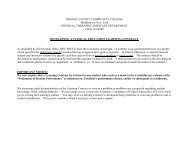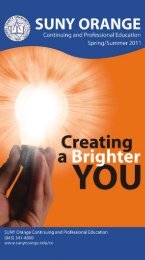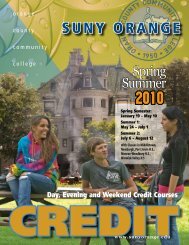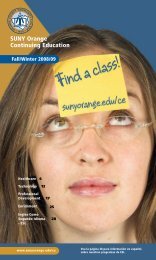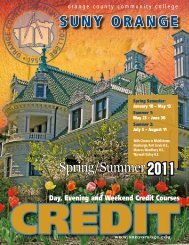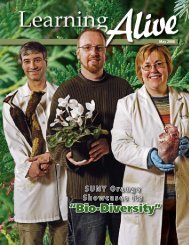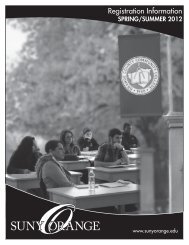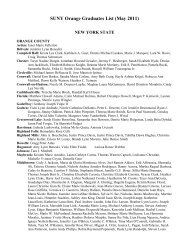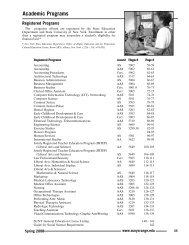Create successful ePaper yourself
Turn your PDF publications into a flip-book with our unique Google optimized e-Paper software.
Electrical Technology—Telecommunications<br />
Electrical Technology—<br />
Telecommunications<br />
(Applied Technologies Department)<br />
EET 101—Electric Circuits<br />
3 lect., 3 lab., 4 cr. (Fall)<br />
A study of the fundamentals of DC & AC circuit<br />
theory. Topics include DC circuits (series, parallel and<br />
combinational) and network theorems (Thevinin,<br />
superposition and loop analysis), AC waveforms,<br />
capacitance(RC circuits), inductance(RL circuits) and<br />
complex AC circuits(RCL), including complex circuit<br />
analysis and passive filter applications. The course<br />
also includes a 1.5 credit technical writing component.<br />
Corequisite: MAT 102 or higher, ENG 160<br />
EET 104—Digital Electronics 1<br />
3 lect., 3 lab., 4 cr. (Spring)<br />
This course begins with a basic understanding of digital<br />
fundamentals such as binary and hex numbers, basic logic<br />
functions, Boolean Algebra, logic minimization and simple<br />
combinational logic circuits. Additional topics such as<br />
electrical characteristics of TTL and CMOS logic are<br />
discussed. The student will then explore a few basic designs<br />
using CAD programs. The student will explore combinational<br />
logic functions, arithmetic circuits, sequential logic,<br />
programmable logic architectures, counters and shift registers,<br />
state machine design, logic DAC and ADC. The student will<br />
be introduced to CPLD applications and VHDL.<br />
Prerequisite: MAT 020 or placement into MAT 101<br />
or higher<br />
EET 106—Telecommunications 1<br />
2 lect., 4 lab., 4 cr. (Spring)<br />
This course is designed to form a basis for a career<br />
in telecommunications. Students will gain a<br />
comprehensive understanding of telecommunications<br />
technologies, their applications, and their implications<br />
for business. The focus will be telecommunications<br />
basics, switching and routing and telecommunications<br />
networking. On-site telecommunications laboratory<br />
will provide students with hands-on experience.<br />
Prerequisite: EET 101, MAT 107 or higher<br />
EET 107—Telecommunications 2<br />
2 lect., 4 lab., 4 cr. (Fall)<br />
This course covers advanced electronic telecommunications<br />
concepts. It is intended to provide the technician<br />
with a working knowledge of digital data telecommunication<br />
systems and components. The focus will continue with<br />
Telecommunications Networking, communications service<br />
providers, Telecommunications applications and emerging<br />
technologies<br />
Prerequisite: EET 106<br />
EET 110—Computer Applications & Graphics<br />
2 lect., 2 lab., 3 cr. (Fall/Spring)<br />
This entry level course is designed to introduce the<br />
student to computer graphical concepts and the visual<br />
display of information. Topics include layouts, charts,<br />
drawings, illustrations, computer aided design, image<br />
manipulation and enhancement, and graphic<br />
presentations. Projects include graphical techniques<br />
and analysis for graphic arts, medical imaging, and the<br />
sciences. Applications used include word processing,<br />
spreadsheet, databases, graphical presentation, photo<br />
editing, illustrating and computer aided design.<br />
EET 201—Electronics 1<br />
3 lect., 3 lab., 4 cr. (Fall)<br />
A study of basic semiconductor theory, diodes, bipolar<br />
transistors and FET’s, bias circuits, amplifiers, frequency<br />
response, diff amps, and an introduction to semiconductor<br />
processing. Emphasis is placed on circuit and system design.<br />
Prerequisite: EET 101<br />
EET 202—Electronics 2<br />
3 lect., 3 lab., 4 cr. (Spring)<br />
A study of of amp theory, configurations and<br />
applications. Circuit design problems are used<br />
throughout to emphasize real design situations.<br />
Circuit simulation is used to provide a base for<br />
prototyping and then bench testing real systems.<br />
Topics include op amp configurations, summing<br />
amps, Integrators and Differentiators, Log amps, D to<br />
A and A to D and a variety of control applications.<br />
Prerequisite: EET 201<br />
EET 204—Digital Electronics 2<br />
3 lect., 3 lab., 4 cr. (Spring)<br />
An in-depth look at Microprocessors, digital interface<br />
circuits (bus controllers, latches\I/O techniques and memory<br />
mapping), Microcontrollers and assembly language<br />
programming. Micro controller applications design and<br />
hardware system design are also be covered. A number of<br />
analog control applications are designed and implemented.<br />
The course uses the Motorola 68HC11 system.<br />
Prerequisite: EET 104<br />
EET 206—Telecommunications 3<br />
2 lect., 4 lab., 4 cr. (Fall)<br />
A study of basic RF systems, Analog systems (AM<br />
& FM), digital data techniques and protocols,<br />
antennas, wave propagation, satellite systems, wireless<br />
networks and cellular/PCS systems. The course also<br />
includes a semester long communications project that<br />
includes a 1.5 credit technical writing component.<br />
Prerequisites: EET 106<br />
EET 230— Internship: Technology<br />
3 cr. (Fall/Spring)<br />
Students are assigned to a work study experience in<br />
an appropriate technology field at an off-campus site<br />
o1r provided with on-campus project work. The<br />
particular interests of the student in the field are<br />
considered in arranging the field experience.<br />
Enrollment by permission of the department chair.<br />
Spring 2012<br />
www.sunyorange.edu<br />
193




